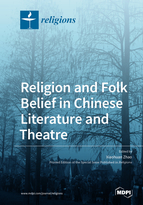Religion and Folk Belief in Chinese Literature and Theatre
A special issue of Religions (ISSN 2077-1444). This special issue belongs to the section "Religions and Humanities/Philosophies".
Deadline for manuscript submissions: closed (31 October 2021) | Viewed by 28452
Special Issue Editor
Interests: art and archaeology; magic, myth, and ritual; Chinese musical drama; history of Chinese theatre; Chinese folk and temple theatre; Chinese folk religion and ghostlore
Special Issue Information
Dear Colleagues,
There has never been a shortage of research on religion and folk belief in Chinese literature and theatre. Most of the research has been conducted from a historical perspective and has focused on the role of religion in the development of Chinese literature and theatre, with little attention given to the interactive relationship between religious beliefs and practices and Chinese literature and theatre; let alone the multiple functions of religion and folk belief in the broader socio-cultural context of Chinese literature and theatre. In view of this, the Special Issue addresses the bidirectional relationship of religion and folk belief to literature and theatre. By "bidirectional relationship", a dynamic and interactive relationship is meant, in which religious beliefs and practices engender and inspire literature and theatre and are, in turn, enriched and nourished by literature and theatre. Thus, the broader question that the Special Issue seeks to answer is how we interpret and appreciate the various forms and functions that the relationship assumes between religion and folk belief and literature and theatre in general and between gods and humans, ghosts and spirits, mortals and immortals, temple and theatre, ritual performance and theatre performance, efficacy and entertainment, saints and shamans, cults and ceremonies, dream and reality, magic and myth, strange beings and strange happenings, the occult and the mundane, divination and revelation, trance and dance, prophecy and necromancy, in particular.
Dr. Xiaohuan Zhao
Guest Editor
Manuscript Submission Information
Manuscripts should be submitted online at www.mdpi.com by registering and logging in to this website. Once you are registered, click here to go to the submission form. Manuscripts can be submitted until the deadline. All submissions that pass pre-check are peer-reviewed. Accepted papers will be published continuously in the journal (as soon as accepted) and will be listed together on the special issue website. Research articles, review articles as well as short communications are invited. For planned papers, a title and short abstract (about 100 words) can be sent to the Editorial Office for announcement on this website.
Submitted manuscripts should not have been published previously, nor be under consideration for publication elsewhere (except conference proceedings papers). All manuscripts are thoroughly refereed through a double-blind peer-review process. A guide for authors and other relevant information for submission of manuscripts is available on the Instructions for Authors page. Religions is an international peer-reviewed open access monthly journal published by MDPI.
Please visit the Instructions for Authors page before submitting a manuscript. The Article Processing Charge (APC) for publication in this open access journal is 1800 CHF (Swiss Francs). Submitted papers should be well formatted and use good English. Authors may use MDPI's English editing service prior to publication or during author revisions.
Keywords
- religion
- ritual
- folk belief
- myth
- Chinese literature
- Chinese theatre






